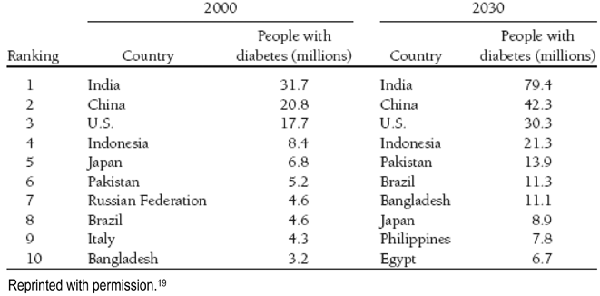
The increasing incidence of diabetes in children, young adults, the elderly, and members of disadvantaged and transitional populations is responsible for an increasing incidence of DKD in these groups. Racial/ethnic differences in susceptibility to DKD also may play a role. In pregnant women, the presence of diabetes and CKD may adversely affect the health of both the mother and her offspring.
3.1 Screening and interventions for diabetes and CKD should focus on populations at greatest risk. (C)
3.2 Although management of diabetes and CKD in special populations should follow the same principles as management in the majority population, there are special considerations in the treatment of children, adolescents, and the elderly. (C)
3.3 Population-based interventions may be the most cost-effective means for addressing the burden of CKD in special populations. Implementation and evaluation of population-based interventions should take into account the heterogeneity of the populations at risk. (C)
3.4 Specialists in high-risk pregnancy and kidney disease should co-manage pregnancy in women with diabetes and CKD. (C)
3.5 Treatment of DKD with RAS inhibitors before pregnancy may improve fetal and maternal outcomes, but these medicines should be discontinued as soon as a menstrual period is missed or after a positive pregnancy test. (C)
3.6 Insulin should be used to control hyperglycemia if pharmacological therapy is necessary in pregnant women with diabetes and CKD. (C)
This CPR addresses 4 distinct, but overlapping, groups with diabetes and CKD: children and adolescents, pregnant women, the elderly, and members of disadvantaged and transitional populations. The latter group is made up predominantly, but not exclusively, of people from less-developed countries undergoing economic and social change and by racial and ethnic minorities in developed countries.
In the United States, the burden of diabetes and CKD is borne disproportionately by ethnic and racial minorities. Worldwide, populations of developing countries appear to be at greatest risk of developing diabetes and CKD during the next several decades. Early intervention in these high-risk populations provides the best opportunity for reducing the morbidity and mortality associated with diabetes and CKD. Children79 and elderly people496 who are members of these populations appear to be at particularly high risk of morbidity associated with DKD. Moreover, the number of young women with diabetes who become pregnant and already have kidney disease is increasing, yet little is known about the effect of diabetes and CKD on these women or on their offspring.
This CPR describes the burden of diabetes and CKD in special populations and suggests strategies for improving care in these highly susceptible groups. Maternal and fetal outcomes among pregnant women with type 1 diabetes and CKD also are described. However, few studies have evaluated the benefit of treating pregnant women who have diabetes and CKD with interventions aimed at decreasing the risk of maternal and fetal adverse outcomes, and none of these studies included women with type 2 diabetes or with CKD stage 5 treated by either kidney transplantation or dialysis.
The worldwide epidemic of diabetes disproportionately affects the developing world. (Strong)
The global burden of diabetes is expected to double between 2000 and 2030, with the greatest increases in prevalence occurring in the Middle East, sub-Saharan Africa, and India.19 Much of this increase will be driven by urbanization and the increase in the population older than 65 years. Countries with the highest numbers of estimated cases of diabetes in 2000 and projections for 2030 are shown in Table 50. Development of diabetes during the childbearing years also will increase, primarily in the developing countries (Fig 27). 19 Projections of the future burden of diabetes in the US population suggest that the prevalence of diabetes will increase 165% between 2000 and 2050, from 11 to 29 million, with the greatest increases in the population older than 75 years and among African Americans.18
As the population of patients with diabetes with significant duration of disease grows, reports of a dramatically increasing burden of diabetic CKD are appearing from Africa,22,23 India,24 Pacific Islands,25 and Asia,26,27 where infectious disease previously posed the greatest threat.28 Increased risk and more rapid progression of DKD29,30 also have been reported in immigrants to Europe from South Asia.31,32
Table 50. Countries With the Highest Numbers of Estimated Cases of Diabetes for 2000 and 2030.

Minorities bear a disproportionate burden of diabetic CKD in the United States. (Strong)
Disparities in the incidence of diabetic CKD stage 5 among racial/ethnic groups in the United States have existed for many years, but the magnitude of these disparities has increased in recent years (Fig 28) . Between 1999 and 2002, a total of 35% of the new cases of CKD stage 5 due to diabetes in the United States were members of racial minorities, with incidence rates 4 times as high among African Americans and American Indians than among whites.4 Excess burden of CKD also is well documented among Pacific Islanders497,498 and Hispanics.499 Several studies suggest a greater risk and more rapid development of DKD in racial minorities, and these studies attribute the increased susceptibility to both genetic factors496, 500-503 and socioeconomic barriers, including decreased access to care.504
Special populations may demonstrate different patterns of comorbid conditions and a different course of CKD than the majority population. (Moderate)
The natural history of diabetic complications may be falsely perceived as benign when diabetes first emerges as a major problem in a population because few people will have diabetes of sufficient duration to develop the usual complications.505 Nevertheless, once diabetes has established itself, differences in the rate of development and frequency of diabetic complications, including CKD, have emerged among racial/ethnic groups.82, 506, 507 These differences may be attributable to such factors as age at onset of diabetes,82 diet, exercise patterns, living conditions, access to medical care, education, infections, environmental toxins, and inherited susceptibility.
The frequency of nondiabetic CKD differs among special populations with diabetes. (Moderate)
Higher rates of non-DKD in people with diabetes have been documented in Zuni Indians508 and Aborigines,509 emphasizing the importance of a careful diagnostic evaluation in patients with diabetes from high-risk groups. In populations with decreased access to care, when care is often received only late in the course of disease, the cause of kidney disease may be attributed, by default, to the most common cause in that group (eg, hypertension in African Americans510 and type 2 diabetes in American Indians) without adequate investigation.
Figure 27. Estimated Number of Adults with Diabetes by Age Group and Year for the Developed and Developing Countries and for the World.
Reprinted with permission.19
Diabetes and CKD are increasing among children and adolescents. (Strong/Moderate)
The worldwide increase in childhood obesity has increased the prevalence of type 2 diabetes among children and adolescents.511 Whereas all populations in the United States have shown dramatic increases in the overall prevalence of obesity (>10% in 2- to 5-year-olds and >15% in 6- to 19-year-olds), the greatest increases have occurred in ethnic and racial minorities.512 At the same time, there has been a worldwide increase in the incidence of type 1 diabetes, particularly among children younger than 5 years old.17 Given that duration of diabetes, rather than age of onset, is the more predominant risk factor for DKD, increasing rates of both type 1 and type 2 diabetes in children and adolescents undoubtedly will lead to an increase in DKD in these age groups, a finding that is already being reported in some populations.79, 80, 82
In many racial/ethnic groups, type 2 diabetes has already become—or is rapidly becoming—the predominant cause of childhood diabetes.72, 513, 514 While optimal treatment of childhood type 2 diabetes is essential to reduce the burden of DKD, public health interventions that promote proper diet and increase exercise may offer the best opportunity to reduce disease burden through primary prevention of obesity and diabetes.71
Children and adolescents with diabetes and CKD have special treatment considerations. (Weak/Opinion)
CKD stage 3 or greater due to DKD is rare in children and adolescents. Also, children and adolescents are more likely to revert from microalbuminuria to normoalbuminuria than adults (see Guideline 1). Nonetheless, those children and adolescents with diabetes and CKD pose a number of unique concerns. Accordingly, specialists in diabetes and kidney disease with experience in these age groups should be involved in their care. Data regarding treatment of hyperglycemia, hypertension, and dyslipidemia in children with diabetes and adolescents with CKD are almost nonexistent. However, therapeutic lifestyle changes (diet, exercise, and weight loss, when appropriate) are prudent for each of these risk factors. In the opinion of the Work Group, treatment goals for glycemia in type 1 diabetes and CKD should follow the American Diabetes Association (ADA) Standards of Care for children and adolescents (Table 51).174 Given the greater risk of hypoglycemia in those with decreased kidney function, treatment goals must be carefully individualized. In patients with type 2 diabetes, therapeutic lifestyle changes should be the initial interventions for hyperglycemia.513 If lifestyle changes do not succeed in achieving a goal of near-normal glycemia (HbA1c < 7%), drug therapy should be initiated.513 Although the ADA recommends oral agents as first-line therapy for children or adolescents with type 2 diabetes, only metformin is approved by the Food and Drug Administration (FDA) for this use—and only in children older than 10 years. However, metformin should be avoided in children and adolescents with diabetes and CKD. Cautions regarding the use of other oral agents in children and adolescents with diabetes and CKD are the same as those described for adults (Guideline 2, Table 22), with the exception that TZDs should not be used because of concerns about liver toxicity due to the experience with troglitazone.
Figure 28. Adjusted Incident Rates of CKD Stage 5 Due to Diabetes by Race/Ethnicity.
Incident CKD stage 5 patients adjusted for age and gender. For Hispanic patients, we present data beginning in 1996, the
first full year after the April 1995 introduction of the revised Medical Evidence form, which contains more specific questions on race and ethnicity. The data reported here have been supplied by the US Renal Data System (USRDS). The interpretation
and reporting of these data are the responsibility of the author(s) and in no way should be seen as an official policy or
interpretation of the US government.4
According to the NKF-KDOQI™ CPGs on Hypertension and Antihypertensive Agents in CKD, the target blood pressure in children and adolescents with CKD is less than the 90th percentile for age, sex, and height or less than 130/80 mm Hg, whichever is lower.5 The ADA recommends a similar goal in children and adolescents with diabetes.174 Therefore, in the opinion of the Work Group, a target blood pressure less than the 90th percentile for age, sex, and height or less than 130/80 mm Hg, whichever is lower, should be applied to children and adolescents with both CKD and diabetes. Although not approved for use by the FDA, both the NKF and the ADA suggest that ACE inhibitors are the drugs of choice for treatment of blood pressure in children and adolescents with diabetes and/or CKD.5,174 ARBs are reasonable alternatives if ACE inhibitors are not tolerated.5 Adolescent girls must be counseled fully and repeatedly about pregnancy prevention while on ACE inhibitors or ARBs and about immediate discontinuation of these agents should pregnancy be suspected.
Drug therapy should be considered for either severe hypertriglyceridemia (triglycerides > 500 mg/dL) or marked elevations in LDL-C (>160 mg/dL) that are unresponsive to control of hyperglycemia or therapeutic lifestyle changes as outlined in the NKF-KDOQI™ CPGs on Managing Dyslipidemias in CKD.6 Fibric acid derivatives are the preferred agents for hypertriglyceridemia, but they are not FDA approved for use in children or adolescents. Statins are preferred for elevated LDL-C levels, and atorvastatin has received FDA approval for use in children and adolescents with familial hypercholesterolemia. The ADA suggests an LDL-C target of less than 100 mg/dL in children and adolescents with diabetes.174 Adolescent girls must be counseled fully and repeatedly about pregnancy prevention while on statin therapy and about immediate discontinuation of these agents should pregnancy be suspected.
Children and adolescents should be referred to a registered dietitian experienced in managing diabetes and CKD in this age group. For those who are obese, weight loss strategies should include both increased physical activity and a well-balanced diet. As per Guideline 5, high-protein diets (>20% of calories) should be avoided in children and adolescents with diabetes and CKD. However, low-protein diets (<10% of calories) also should be avoided because of concerns about providing adequate nutrition for growth and development and because proof of efficacy is lacking in this age group.
Table 51. Plasma Blood Glucose and HbA1c Goals for Type 1 Diabetes by Age Group
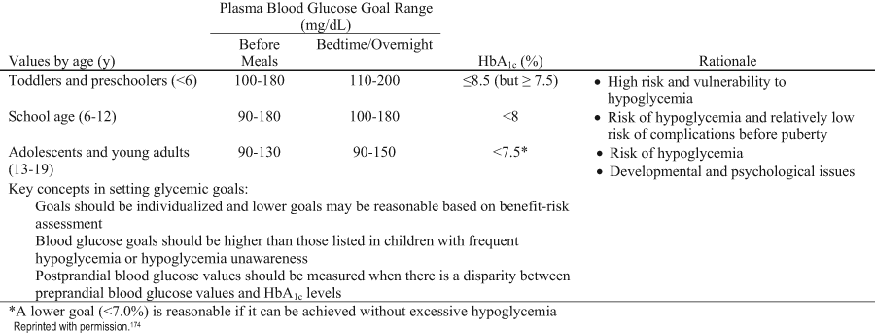
Elderly people with diabetes and CKD have special treatment considerations. (Weak/Opinion)
Elderly people with diabetes and CKD often have a number of comorbidities, particularly CVD, as well as cognitive and functional impairments. Therefore, the benefits of intensive risk factor management should be considered judiciously in light of these increased risks. Because hypoglycemia and hypotension are particular concerns, less intensive goals should be considered based on individual circumstances. Drug therapies for hyperglycemia, hypertension, and dyslipidemia can be used as in other patients with diabetes and CKD. However, drugs should be started at low doses and carefully titrated to monitor for responses and side effects.
The greater frequency of comorbid conditions in the elderly with diabetes is responsible for a greater prevalence of elevated albuminuria unrelated to DKD. Accordingly, the appearance of elevated albuminuria is less likely to be a sign of progressive kidney disease, even in those with diabetes of long duration.515 GFR may be a more specific marker of DKD in the elderly compared with albuminuria.516 Development of diabetic complications, including CKD, is associated strongly with mortality in elderly people,517 and poor outcomes are associated with nonadherence to the medical regimen.518 The high cost for caring for elderly people with CKD may be reduced through the aggressive management of CVD.519
The presence of microalbuminuria in pregnant women with type 1 diabetes increases risks of adverse maternal and child outcomes, including preeclampsia and preterm delivery. Macroalbuminuria further increases these risks and also may increase risk of perinatal mortality. (Strong/Moderate)
Case-control and cohort studies involving more than 1,300 pregnant women with type 1 diabetes were reviewed to identify adverse maternal and child outcomes in pregnancies complicated by both diabetes and CKD (Table 52) and the predictors of these adverse outcomes (Table 53). All entries in the summary tables refer to these studies in type 1 diabetes. Microalbuminuria increases risks of preeclampsia and preterm delivery up to 8 times.520, 521 Macroalbuminuria further increases these risks to more than 30 times522-524 (Table 52). Macroalbuminuria also appears to increase the risk of preterm birth, small-for-gestational-age infants, and perinatal mortality independent of preeclampsia525-527 Furthermore, higher HbA1c in the first trimester of pregnancy increases the risk of major malformations (Table 53).528 Therefore, women with diabetes and CKD who are pregnant should be monitored and treated as high-risk patients. In the opinion of the Work Group, pregnant women with diabetes and CKD should be co-managed by specialists in high-risk pregnancies and kidney disease.
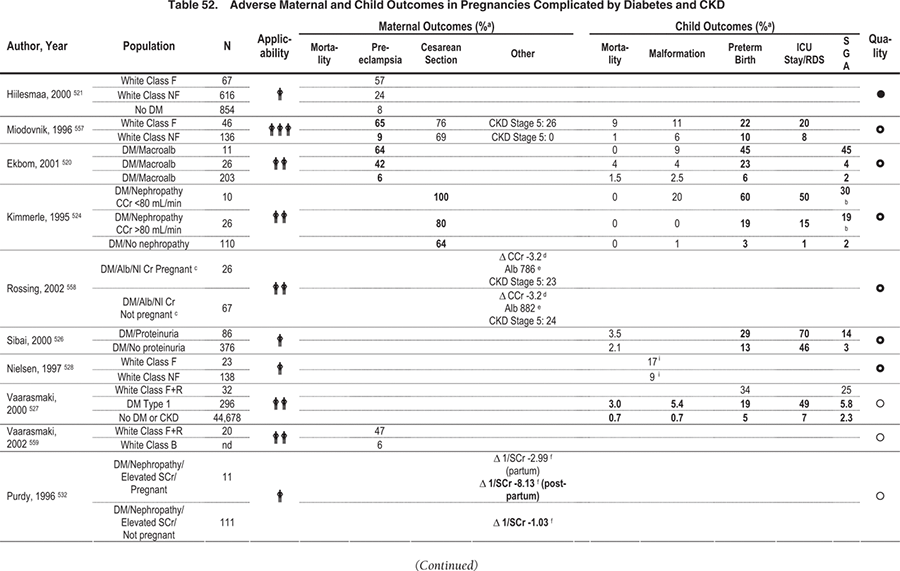
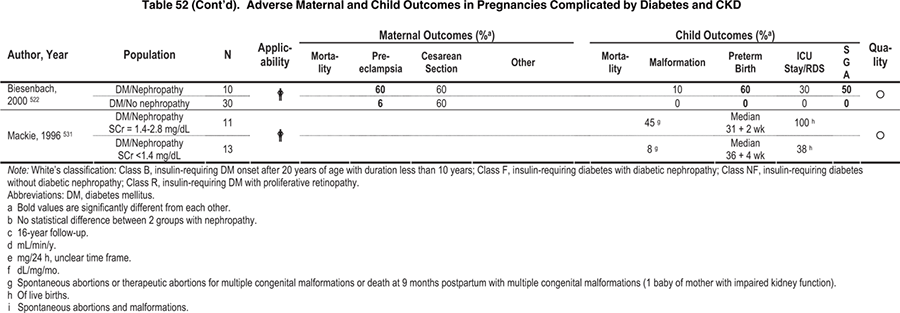
Albuminuria in pregnant women with type 1 diabetes does not increase the risk of worsening of DKD unless kidney function also is impaired. (Strong/Moderate)
Only a few studies have explored the progression of DKD in pregnant women. Clinically significant worsening of kidney disease is apparent only in women who already have increased baseline levels of serum creatinine and albuminuria. These patients have a greater GFR decline during pregnancy and a higher risk of progression to CKD stage 5 after delivery.520,524, 529-532
The effect of CKD on the outcome of pregnancy in women with type 2 diabetes is unknown. (Opinion)
Due to the increasing prevalence of type 2 diabetes in younger women, some may become pregnant after the development of kidney disease. In the absence of data regarding pregnancy in women with type 2 diabetes and CKD, it is the opinion of the Work Group that they should be managed according to the same principles as women with type 1 diabetes and CKD because their risks are likely to be at least as great as in women with type 1 diabetes.
Medical management of CKD should be adjusted during pregnancy in women with diabetes. (Weak/Opinion)
Recommendations regarding the medical management of hypertension, hyperglycemia, dyslipidemia, and nutrition in pregnant women with diabetes and CKD are outlined in Table 54.
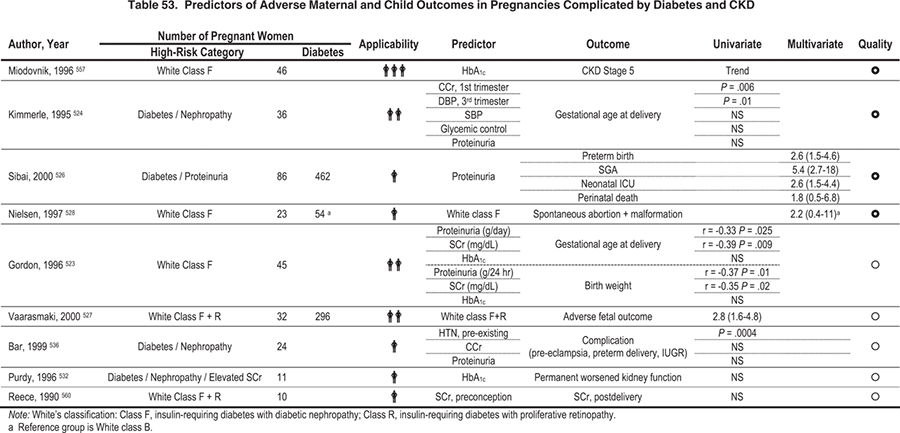
Table 54. Management of Pregnant Women With Diabetes and CKD174, 533-535
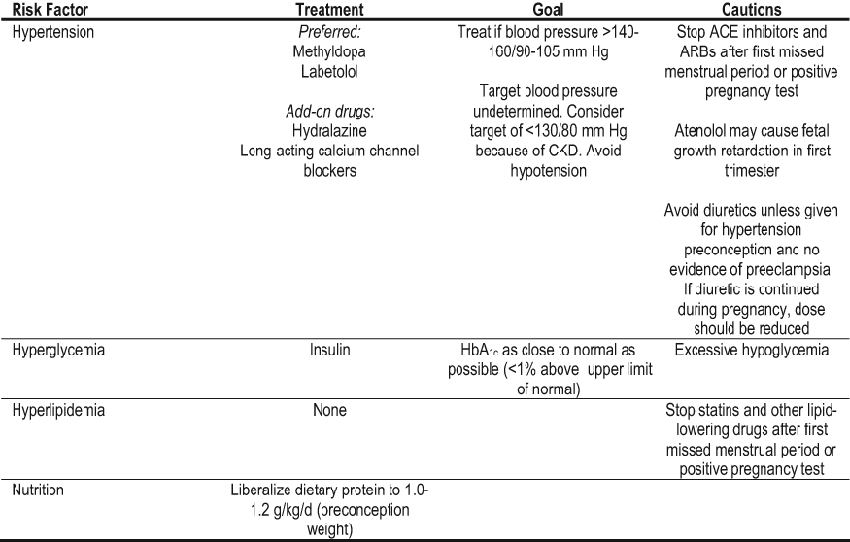
ACE inhibitors and ARBs should be stopped at the first indication of possible pregnancy in women with diabetes and CKD. Methyldopa and labetolol are preferred antihypertensive agents during pregnancy. (Weak/Opinion)
Uncontrolled studies of women with diabetes, macroalbuminuria, and normal GFR who were treated with captopril, 37.5 to 75 mg/d, for at least 6 months before pregnancy and discontinued immediately after a missed menstrual period or a positive pregnancy test showed no deterioration of kidney function 2 years after delivery.536, 537 ACE inhibitors and ARBs have adverse effects on the fetus during the second and third trimester, including acute kidney failure in neonates, lung toxicity, and skull hypoplasia.538 Emerging evidence suggests that risk of fetal abnormalities (congenital malformations of the cardiovascular system, central nervous system, and kidney) during ACE-inhibitor treatment extends to the first trimester.539 Therefore, RAS inhibitors should be discontinued immediately after a missed menstrual period or a positive pregnancy test in women with diabetes and CKD.5 Women and adolescent girls with childbearing potential who are treated with RAS inhibitors should be counseled about these risks.
Treatment of hypertension should follow the guidelines adopted by the American College of Obstetrics and Gynecology.533 Because antihypertensive therapy does not reduce the risk of preeclampsia and may cause potential harm to the fetus, hypertension should be treated cautiously. Based on extensive experience, methyldopa has long been considered the drug of choice by many experts. Labetolol now also is considered a preferred agent because combined α- and β-blockade may better preserve uterine perfusion. β-Blockers are considered reasonable add-on or alternative therapies. However, some data suggest that atenolol early in pregnancy may cause fetal growth retardation. Long-acting calcium channel blockers or hydralazine also are considered reasonable add-on therapy. Diuretics usually are avoided in pregnancy, particularly when there are concerns about preeclampsia. However, if a pregnant woman with chronic hypertension has been treated with a diuretic before conception, it is not necessary to discontinue the therapy as long as there are no signs of preeclampsia. Nevertheless, most experts recommend reducing the diuretic dose and carefully monitoring the patient.534, 535
Insulin is the preferred pharmacological therapy for hyperglycemia in pregnant women with diabetes and CKD. (Opinion)
Oral antidiabetic medicines have successfully controlled hyperglycemia in women with type 2 diabetes during pregnancy, but these studies did not include patients with CKD.540, 541 In the opinion of the Work Group, insulin remains the pharmacological treatment of choice for hyperglycemia during pregnancy in women with diabetes and CKD, and goals for glycemic control should be the same as those for women without CKD.542-544
Dyslipidemia should not be treated during pregnancy in women with diabetes and CKD. (Opinion)
Pharmacological treatment of lipid abnormalities during pregnancy is not currently recommended due to potential risks to the fetus.545 Nevertheless, maternal hypercholesterolemia is associated with the development of fetal atherosclerosis,546 so this recommendation may change as results of additional studies of statins and other agents during pregnancy become available. However, until such studies are available, it is the opinion of the Work Group that statins and other lipid-lowering therapies should be discontinued after a missed menstrual period or a positive pregnancy test result in women with diabetes and CKD. Women and adolescent girls with childbearing potential who are treated with lipid-lowering therapies should be counseled about these risks.
Dietary protein intake should not be restricted during pregnancy in women with diabetes and CKD. (Opinion)
Limitation of dietary protein in women with diabetes and CKD should be liberalized during pregnancy to ensure adequate nutrition for the fetus. In the opinion of the Work Group, these patients should be counseled to increase their intake of protein to 1 to 1.2 g/kg (prepregnancy weight) per day.
Pregnant women with diabetes and CKD stage 5 treated by kidney transplantation or dialysis should be managed according to the recommendations for earlier stages of CKD. (Opinion)
Pregnant women with diabetes and CKD stage 5 (kidney transplantation or dialysis) have not been included in treatment studies. Therefore, in the opinion of the Work Group, strategies for the management of hyperglycemia, hypertension, and dyslipidemia may be extrapolated from the recommendations for women with earlier stages of CKD. The scope of the evidence review did not include specific management of CKD stage 5 in pregnancy.
Population-based interventions in special populations, including systematic community screening and surveillance, have been successful in reducing the burden of DKD, particularly when they are applied early in the course of the disease.547, 548 Such approaches, including the NKF Kidney Early Evaluation Program, are effective in identifying asymptomatic people with CKD from high-risk populations.549 Interventions targeted at high-risk special populations and implemented in the primary care and community settings have reduced the rate of diabetic complications, including CKD stage 5.550-552 Successful community-based model programs have been implemented in Australian Aboriginal communities553 and rural India.554
Poor access to care and late referral for nephrological intervention are associated with poor outcomes in United States racial minorities.555 Improving outcomes for special populations will require not only changes in standards of clinical care, but also efforts to improve access to care for these high-risk groups. Understanding the cultural and socioeconomic milieu of the target populations is essential for successful interventions.556
Addressing the increased burden of diabetes and CKD in developing countries where health resources are severely limited will require creativity and collaboration with public health professionals. Unfortunately, the increase in diabetes and other chronic diseases is occurring in many countries that are still experiencing a high prevalence of infectious disease, including an increase in the burden of HIV/AIDS. Limited resources may be strained by these competing health problems.